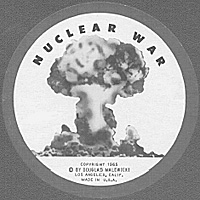 Designer: Douglas Malewicki
Designer: Douglas Malewicki
Publisher: Nuclear War Game Co., 1965
Players 2 to 6
Playing Time 15 to 30 minutes
Era Cold War
Scale Abstract cards
Components
1 box 5 1/2" x 7 1/2" x 1", with two cardboard dividers
1 9 1/2" x 12" sheet of rules, folded twice
1 cardboard spinner 5"x7" with riveted metal arrow, black on red
85 Nuclear War cards 2 1/2" x 3 1/2"
10 Secret cards 2 1/2" x 3 1/2"
5 Top Secret cards 2 1/2" x 3 1/2"
40 People cards 1 1/2" x 2 1/2"
People Card Manifest
10 1 Million
10 2 Million
10 5 Million
6 10 Million
4 25 Million
 Nuclear War Card Manifest
Nuclear War Card Manifest
9 Polaris missiles (10 Megatons)
9 Atlas missiles (20 Megatons)
6 B-70 bombers (50 Megatons)
3 Saturn missiles (100 Megatons)
19 10 Megaton warheads
10 20 Megaton warheads
4 50 Megaton warheads
1 100 Megaton warhead
4 Anti-Missile missiles (types P, A, B & S)
20 Propaganda cards
12 5 million defect
6 10 million defect
2 25 million defect
What the designer says:
“Nuclear War is a game for two to six players. Each player represents a ‘major world power’ and attempts to gain world domination through the strategic use of propaganda techniques or nuclear weapons. Population is therefore the measure of success or failure in the game. A player who loses his entire population withdraws from the game.”
What the reviewers say:
“[I]t is not a true wargame, at least not in the sense generally accepted. It is, however, a very relaxing, ‘fun’ game to play. We can heartily recommend it to anyone who just wants to have a good time.” M.G. Smedley in S&T 3.
“The game will not appeal to the so-called realism buff. But if you are fond of Diplomacy, Kingmaker, Origins of WWII and the like, you’ll love this game. It plays fast, and there is plenty of excitement from beginning to end.” Don Lowry in Campaign 78.
Game History
Rick Loomis of Flying Buffalo had created Nuclear Destruction and unveiled it at a game convention. Several people visited his booth inquiring about replacement decks for the game, under the mistaken impression that he was selling Nuclear War. Rick knew of the game, and that it was out of print, being “abandoned” in 1969 when Douglas Malewicki realized he was in fact losing money on every copy he sold. Rick acquired the exclusive licensing rights in 1972, created and published the first expansion, Nuclear Escalation, in 1982 and the second, Nuclear Proliferation, in 1992.
Nuclear War is one of Flying Buffalo’s biggest sellers.
Other games by this designer
Negotiate or Die (1975).
Other games of this type
Of non-nuclear card games of population growth and death, there is Plague & Pestilence.
Of nuclear non-card games, there is Nuclear Destruction and NORAD. But there is really nothing quite like Nuclear War, which my stepdaughter loves playing.
Back to Simulacrum Vol. 4 No. 4 Table of Contents
Back to Simulacrum List of Issues
Back to MagWeb Master Magazine List
© Copyright 2002 by Steambubble Graphics
This article appears in MagWeb (Magazine Web) on the Internet World Wide Web. Other articles from military history and related magazines are available at http://www.magweb.com